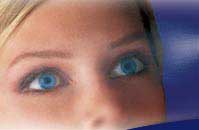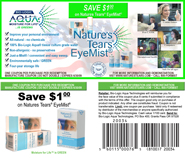
June 10, 2011
Eye Care for Children
Healthy Eyes in Children - What to watch for and what to do.
According to Sharon Kleyne, international entrepreneur and host of the Sharon Kleyne Hour - Power of Water Radio talk show, from the moment of birth, we begin losing water and drying out. All life everywhere is a constant struggle against dehydration. Because eyes (when open) are the only part of the human body not protected by skin, and because the protective tear film covering the eyes is 98 percent water, eyes are extremely vulnerable to water loss and a lot can go wrong - especially in infants.
Parents must learn to become more proactive about their children's eye health and visual development. The time to begin is at birth!
Sharon Kleyne has interviewed numerous pediatric vision care (baby eye care) professionals about eye care for children and infants. Here are excerpts from two of those interviews.
1. Sharon Kleyne interview (partial transcript) with LASIK Pioneer ands eye health advocate Dr. Marguerite McDonald. October 15, 2007:
Sharon Kleyne: What should a parent with a new baby look for regarding vision care?
Dr. McDonald: Actually, better hospitals routinely test infant vision. If there are no problems, they probably won't even mention it. All babies should have a pediatric eye exam, however, because with conditions such as lazy eye, pediatric cataract (present in one birth in 50) or glaucoma, the earlier they are caught, the easier they are to correct. These conditions all cause the eye to send incorrect messages to the brain. Eventually, the brain begins ignoring messages from the bad eye. That's when correction becomes really difficult.
S: Could you talk more about how the eyes communicate with the brain?
M: Technically, the retina is part of the brain. Eye-to-brain pathways begin developing immediately after birth and it is critical that the baby's eyes send correct messages.
S: Do infants ever have dry eye symptoms?
M: Rarely. It is extremely difficult to detect. However, common pediatric medications for asthma and coughs are very dehydrating. In adults, of course, it is estimated that 40,000,000 people suffer from serious, chronic dry eye.
S: What do you recommend for school children with eye complaints?
M: Most schools have vision screening programs. They are able to detect poor vision because all you need is a simple eye chart. Diseases such as dry eye or glaucoma are much harder to detect.
S: Do you have any recommendations about vision and computers?
M: The average eyelid blink rate is 30 to 40 times per minute. When working at a computer, the rate can drop to three times per minute. This can cause dry eye even if your vision is perfect.
S: Have you encountered computer vision syndrome?
M: Frequently. Symptoms are drowsiness, eyes that burn or itch, and blurred vision. Fluctuating vision is also a symptom, where you strain and blink to pull your vision into focus.
S: Could you talk about nutrition and eye health?
M: Sure. Eat lots of dark green leafy vegetables and dark fruits such as blueberries. Also cold water fish and flaxseed oil. These are all excellent for eye health. As a bonus, they are also all rich in antioxidants for heart health.
2. Sharon Kleyne interview (partial summary) with Dr. Scott Jens of the AAO InfantSee program, July 6, 2009.
At age three months, babies start to separate the senses. Before that, the senses all sort of blend together in their perception. To separate the senses, they all must function properly. Eyes more than anything connect the baby to the people and world around them. Eventually, eyes are able to anticipate the other senses (you can often tell by looking at something if its hard or soft, hot or cold) and this is critical to physical coordination and intelligence.
Emotional and behavioral problems could be caused in part by early vision problems. Vision problem can affect walking, hand-eye coordination and other developmental areas. Vision could also be a factor in attention deficit disorder. The link between vision and emotional development is not well established but there is some correlation in early findings.
A parent can easily evaluate a child's vision by observing how it tracks objects and responds to visual stimulation. Factors causing amblyopia (lazy eye) are present from birth, even though the condition may not manifest until age three.
Computer and TV use should be minimal up to age three, then carefully monitored by parents. Children engaging in these activities tend to blink far less (three to four time a minute as opposed to 30 to 40 times a minute), which can lead to excessive tear film water evaporation and dry eye problems. Children (and adults) should take a break at least once very 15 minutes.
In short, start early, observe your baby closely and don't assume everything is OK.
Don't miss the Sharon Kleyne Hour - Power of Water Mondays at 10 a.m. PST/PDT. The syndicated show may be heard on Voice America/World Talk Radio, Green Talk Radio and Apple iTunes. Go to www.SharonKleyneHour.com for summaries and replays of past shows.
Interview links:
McDonald:
http://www.sharonkleynehour.com/Archive2007/Dr.Marguerite.Caring.for.Eyes.php
InfantSee: http://www.sharonkleynehour.com/Archive2009/InfantSEE_Pediatric_Vision_Education_Screening.php









